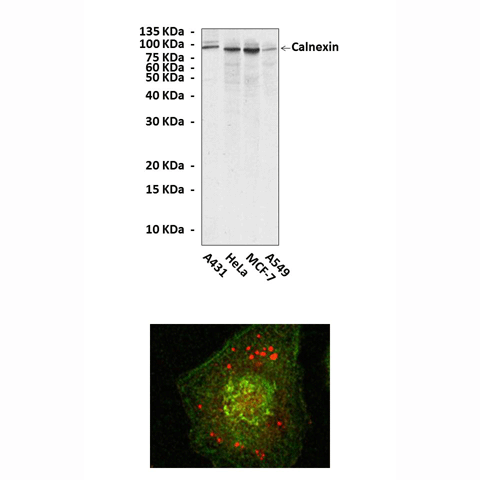Anti-Calnexin: Mouse Calnexin Antibody |
 |
BACKGROUND Calnexin is a new type of molecular chaperone that interacts with many nascent membrane and soluble proteins of the secretory pathway. It is a calcium-binding, endoplasmic reticulum (ER)-associated protein that interacts transiently with newly synthesized N-linked glycoproteins, facilitating protein folding and assembly. Calnexin is unrelated to molecular chaperones of the Hsp60, Hsp70 and Hsp90 families, and is further distinguished from them in that it is an integral membrane protein.1 It may also play a central role in the quality control of protein folding by retaining incorrectly folded protein subunits within the ER for degradation.2 Alternatively spliced transcript variants encoding this protein have been described.
REFERENCES
1. Bergeron, J.J.M. et al:Trend. In Biochem. Sci. 19:124-28, 1994
2. Helenius, A. et al: Trend in Cell Biol. &;193-200, 1997
2. Helenius, A. et al: Trend in Cell Biol. &;193-200, 1997
Products are for research use only. They are not intended for human, animal, or diagnostic applications.
Параметры
Cat.No.: | CP10032 |
Antigen: | Short peptide (CEAAEERPWLWVVYILTVAL) from human Calnexin sequence. |
Isotype: | Mouse IgG2 |
Species & predicted species cross- reactivity ( ): | Human |
Applications & Suggested starting dilutions:* | WB 1:1000 IP 1:50 IHC 1:100 ICC n/d FACS n/d |
Predicted Molecular Weight of protein: | 90 kDa |
Specificity/Sensitivity: | Detects endogenous Calnexin proteins in normal cell lysates without cross-reactivity with other related proteins. |
Storage: | Store at -20°C, 4°C for frequent use. Avoid repeated freeze-thaw cycles. |
*Optimal working dilutions must be determined by end user.
Документы
Информация представлена исключительно в ознакомительных целях и ни при каких условиях не является публичной офертой








